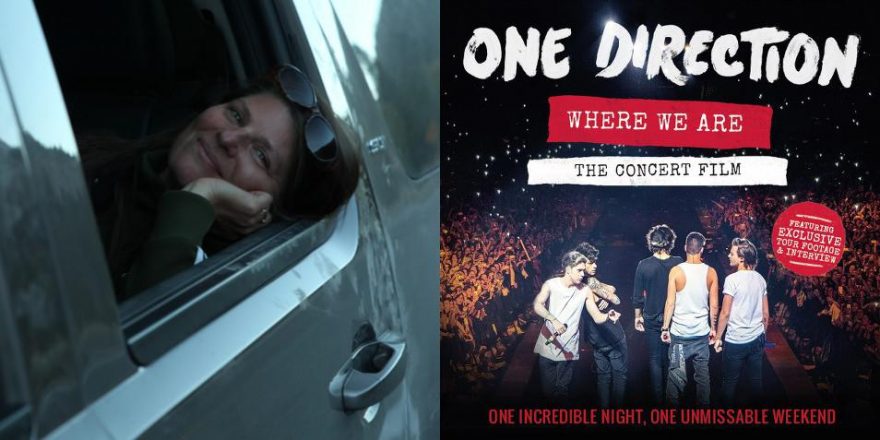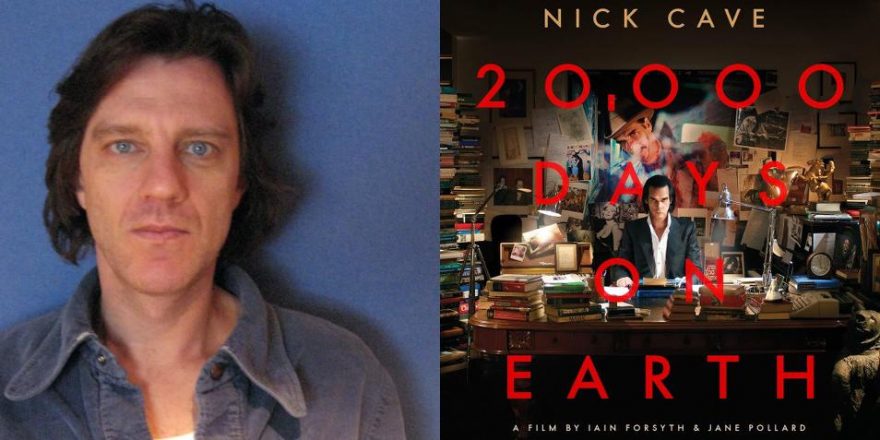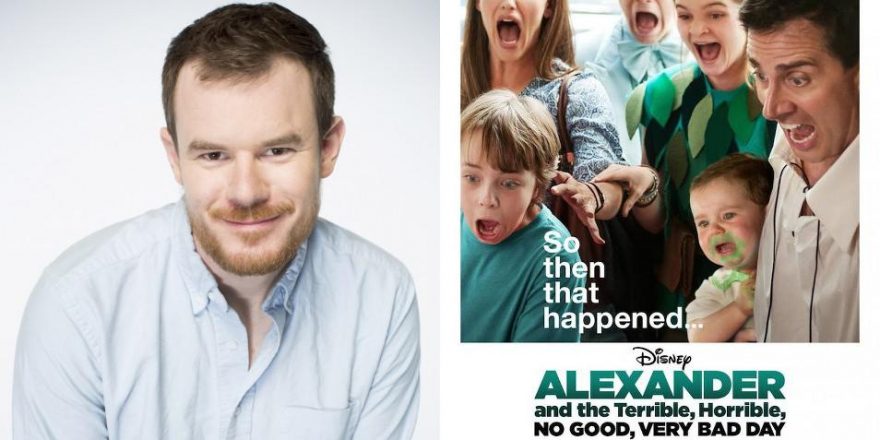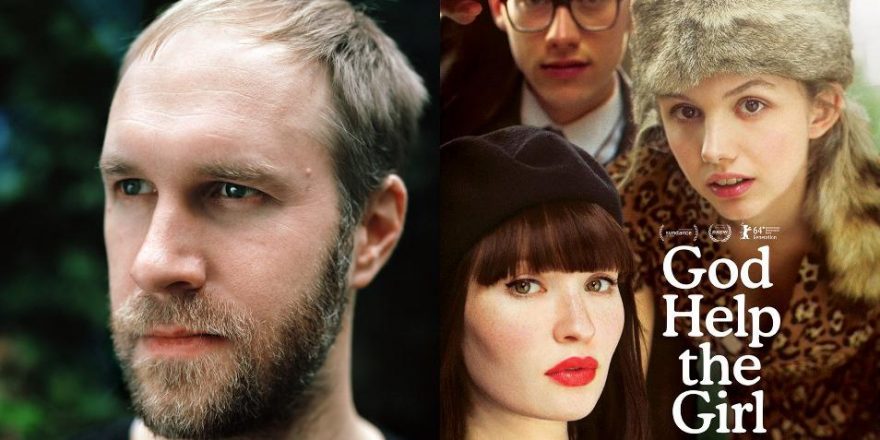It’s calm at first. We’re a little surprised. The room is peppered with (mostly) young women. There is only quiet chatter. We sit in an empty row. Ahead of us, a high-strung mom whips around and asks two teen boys if they’ve saved enough seats. She throws her coat on the seats beside us. We move.
In the back, we’re with an older crowd. More moms, I take it. Here to accompany their daughters to the cinema on a Saturday afternoon in New York City. But as more women in their late twenties take the seats around us, I ask, “Are you guys superfans?”
“I got drunk last night and have a vicious hangover and I’m here. Does that make me a superfan?”
“I just saw the concert in Florida. Does that make me a superfan?”
“We’re sitting in back to hide our shame.”
Thank God we’re back here with them. My 19-year-old niece is here, too. She’s a freshman at NYU. Like me, she’s too old for this. We are here to see One Direction’s new concert film, One Direction: Where We Are — The Concert Film. The massive and intelligent marketing team that backs the brand — I mean, band — has fulfilled the dreams of the average 14-year-old girl more successfully than any pop phenomenon that has ever existed. Do you think the Beatles at Shea Stadium were intense? Hang on.
As the product of an indie generation raised on the cynicism and discontent of 1980s America, I’m all set to be disturbed by this film. Reagan’s hypocrisy and the prevalence of cocaine culture made us DIY kids reject all mainstream-isms; we wouldn’t have touched One Direction with a 10-foot Butthole Surfers flaming torch. We were ACT UP and the Lesbian Avengers and readers of RE/Search Publications’ Angry Women. We made Nirvana and Sonic Youth famous.
So when a marketing magazine can analyze a band’s distribution strategy — peppering its article with phrases like “quarterly targets,” “strategic three-year plans” and “key milestones” — I throw up in my mouth a little. But first, the film itself: Stunningly photographed in Milan, with a million moving cameras flying over the heads of an outrageously gorgeous audience of nine- to 18-year-old girls, and the occasional taller head towering over the rest — a bored dad. Squeals and shrieks build minute by minute, and the clunky 15-minute interview with the band at the beginning makes even non-believers kneel before the onslaught of sincerity and heartfelt boyishness. Foolishly, I turn to NY Niece in shock and ask where the boys’ instruments are. She looks at me funny: “It’s a boy band, Aunty Missy, what did you expect?”
On stage, behind these five gorgeous creatures — too fine ever to be touched by human hands, lest they befoul their exquisite beauty — stands the actual “band” band (i.e., the people who play the music), looking like futuristic robots. About 11 shots in the entire concert film (out of how many? Thousands?) are of people with instruments. They are young, dressed in black and seem to be playing live.
Shut up! They don’t fucking matter! What matters are the five drop dead gorgeous members of One Direction singing directly to me — and only me! Each member of 1D features on a different song (that they wrote? Who the fuck knows?), and I can’t help but bop my head along to each sparkly, catchy musical confection.
And then, when each boy speaks — as he must, to ensure that the personal, intimate nature of this proceeding be cemented in my heart, my brain, my Instagram feed, in every one of my future grandchildren, who will all be named after these demi-gods of boy-next-doorness — then, and only then, is it clear how much each boy really loves me for me.
They speak in a heartfelt and genuine way to each member of the audience (he was looking right at me, I swear) about how much they appreciate us, and we’re forced to realize that One Direction’s just a bit o’ small town boyishness from Ireland and the UK. You could take them home, snuggle in front of the fire, and they would look dreamily into your eyes and tell you Deep Thoughts that they never shared with anyone. Not anyone else. Ever.
And it’s then that I find the secret to 1D’s success. It’s what girl culture thrives on: the deep, meaningful friendship. From letters between Victorian women that sound like passionate missives to the big-eyed animals of Bambi, the Teen Girl simply wants a gal just like her to take her in her arms and hold her just like a boy would.
I develop a theory about One Direction’s fundamental straight queerness. These boys are like girls. In a culture where sensitivity, compassion and respect for women are gendered female, One Direction is my new best friend. And while gay boys are fond of this too, 1D read as hetero-dykes. But I don’t think Niall, Louis, Zayn, Harry or Liam are gay for boys.
They do, however, bring to mind the Japanese Takarazuka Revue, a conservative, all-female theatre company with very traditional ideas about gender roles, whose cross-dressing otokoyaku — women specializing in male roles — are the group’s biggest stars. The mainly female audience is consumed by these actors, who have a similar quality to the masculine gender presentation that One Direction have adopted.
With the assistance of their genius marketers, the One Direction brand accesses lesbian chic and makes these five boy-men the most sensitive, listening friends a gal’s ever known. He/she is a best friend, a non-sexually threatening stuffed animal for cuddling and talk.
Ze isn’t a man, ze is a baby dyke who will take ze’s time to get to know you and love you for who you are — even with that crazy mole on your neck, or those 15 extra pounds you carry. Ze don’t care. Ze love you for you. And ze tells you that in every tweet, Facebook post, Instagram, concert film, perfume ad, Pinterest photo, Tumblr feed, live event and music awards show ze appears in. Ze really don’t care. Because ze have, according to the Sunday Times Rich List, an estimated personal combined wealth of $41.2m, as of April 2013, and we can safely say that ze is happy to love you at that rate of pay. (Not sure where my trans LOLcat vernacular came from, but roll with me here.)
The superfan sitting near me in the theatre exclaims, “Jesus, you want me to fall in love with Niall now? OMIGOD. This is too much. Give me that flask!” They are all just insanely gorgeous. Especially Zayn Malik. Jesus, he’s like a porcelain doll. He’s shy, too. (This is too much even for me. Give me some of that flask, superfan!)
As the cinematic hysteria of the concert film grows to a crescendo, guttural squeals and high-pitched shrieks grow louder until I feel the group energy rise up in myself. I mean, I personally don’t feel anything towards these boys — they are children, after all, albeit gorgeous, physically perfect children who’ve given svelte Porsches and southern Italian villas to their aunties) — and yet the feeling in the room is potent, powerful and sweeping me up in its orgasmic rise. I get tingly and agitated. On screen, the boys describe the post-concert depression their fans undergo — it’s the sadness of realizing that you can never really be with Niall or Zayn, or Harry (Harry!) one on one. It’s a love hangover. A post-coital cry.
The first time I experienced this myself, I was in an Annie Sprinkle/Linda Montano performance (Yay! The ’90s were awesome!) called Metamorphosex. A performance artist, ex-porn star and gifted harnesser of sexual energy, Annie taught me and the other 29 performers to enact a group masturbatory orgasm. It took about 20 minutes, and the audience was caught up in the experience, to say the least. (One night it was only women… holy shit! Crazy energy. Some nights, people would stand afterwards, lighters ablaze, in silent appreciation).
As the orgasmic feeling subsided, I remember sobbing intensely. Like an old pain was leaving me.
And… that is exactly my feeling as the boys of One Direction leave the screen.
The older superfans scurry sheepishly from the theater, while the young women, who aren’t yet old enough to be shamed out of their guilty pleasures, look refreshed and ready for a burger and milk shake.
This is girl culture before it gets ridiculed and trivialized. This is us singing into our hairbrushes, dancing in our rooms, making out with our best friends in grade school because it’s the only outlet for adolescent female desire — so dangerous, wild and unpredictable that it must be destroyed, or channeled.
But wah! We’ve grown up now. And this 1D concert film isn’t as “good” as the first one by Morgan Spurlock, with all that behind-the-scenes material that made us feel part of the boys’ lives. This one is more blatantly a product of Sony’s marketers, and using a special-event digital release strategy.
One Direction: Where We Are — The Concert Film opened in 700 U.S. theaters for one weekend only. And dammit, it made $1.6m, and vicious tabloids say it’s a flop at the box office.
However, if One Direction sucks and is a pure marketing machine, and if it exploits the sexual desires of young women unmercifully, then it does so partly because the younger generations might not make the same rigid distinctions between art and commerce that I and my pre-internet, DIY brothers and sisters did. We threw all of it out with the bathwater. These guys make a perfume from their bathwater and sell it for $29.95 at Target.
But at least One Direction — and their marketing/branding gurus — aren’t ashamed to get a girl off. It’s what we paid for, after all.







